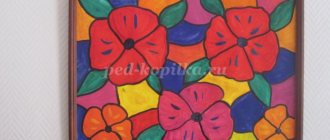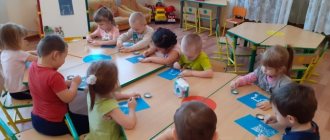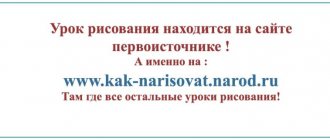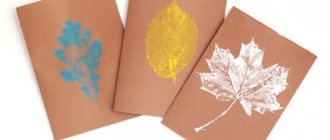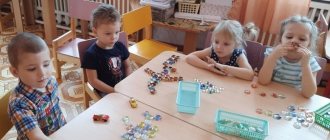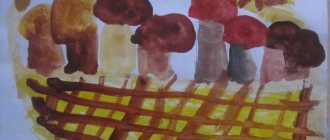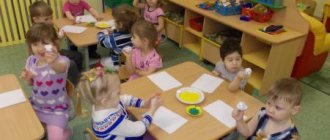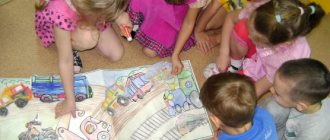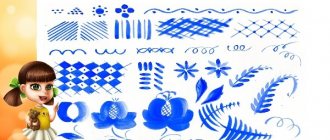"Furniture" GCD in the second junior group
Performed:
Ivanova Elena Yurievna,
teacher
MADOOU Borovsky kindergarten "Zhuravushka"
GCD summary: “Development of mathematical abilities by means of non-traditional drawing in the second junior group on the topic “Furniture”
Goal: To develop children's powers of observation, elementary mathematical concepts, and holistic visual perception of the world around them.
Tasks:
1. Develop the ability to navigate in spatial directions (draw lines from top to bottom, left to right, use the words “on”, “in”, “behind”);
2. Develop the ability to see the general characteristics of objects (shape, color, size, material of manufacture), use the general concept of “furniture”;
3. Continue learning to draw straight lines.
GCD move:
During free play activities, children find a broken doll chair and table.
Children: - Elena Yuryevna!
Educator: - What happened, guys?
Children: - The furniture for the dolls is broken!
Educator: - What a pity... But we can help the dolls! And I know how! Where do you think furniture is made?
— Children's answers (at the factory)
Educator: - Correct!
Educator: - Guys, let's help our toys. I propose to open a furniture factory here. Close your eyes, turn around yourself - one, two, three! We became carpenters!
What pieces of furniture do you know? (children's answers). Bed, chair, table, wardrobe.
What do they sleep on? (on the bed).
Where do clothes go? (into the cupboard).
What are they sitting on? (on the chair)
What do they have lunch for? (At the table)
What is furniture made of? (from boards).
On the table for each child are prepared sheets of dots, as well as gouache and cotton swabs.
In front of the children there is a children's table and chair
Educator: What is there at the table?
Children: Legs and table top. They show.
Educator: What does the chair have?
Children: Seat, back and legs?
Educator: What do a table and a chair have in common?
Children: There are 4 legs, the seat and table top are square, and the table and chair are made of wood.
Educator: To make furniture, you need special drawings, which are called “schemes”. Can you draw? (yes) Then let's try to draw diagrams of a table and a chair...
Before us lie really smooth boards and drawings - mysterious drawings.
Educator: If you look at them carefully, you will see what it looks like: a table or a chair. what should be done?
The dots will help you read the drawing, open the drawing. Try to connect these points with a line (I show you how to do this on the sheet). The guys begin to draw and connect the lines of their drawings.
At the end of the GCD we consider what tables and chairs we got.
Cheerful music plays, the teacher and the children conduct the dance game “We are sitting on chairs.”
Educator: - What wonderful masters you are! Now we can send these drawings of chairs and tables to a furniture factory. And they will make us new furniture for the dolls! And then they will deliver it for our dolls! (put the drawings in a large envelope to send them)
Used Books
- From birth to school. Basic educational program of preschool education / ed. NOT. Veraksy, T.S. Komarova, M.A. Vasilyeva. – 4th ed., revised. – M.: MOSAIKA-SYNTHESIS, 2021. – 352 p.;
- Approximate comprehensive thematic planning for the program “From birth to school.” Second junior group / Ed. T.S. Komarova. - .: MOSAIC-SYNTHESIS, 2021. – 168 pp.;
- Complex classes according to the program “From birth to school” edited by M.A. Vasilyeva, V.V. Gerbova, T.S. Komarova. Second junior group / author-comp. T.V. Kovrigina, M.V. Kosyanenko, O.V. Pavlova. – Volgograd: Teacher, 2013. – 262 p.;
- https://www.maam.ru/detskijsad/konspekt-zanjatija-po-poznavatelnomu-razvitiyu-vo-vtoroi-mladshei-grupe-na-temu-mebel.html
“Certificate of publication in the media” Series A No. 0007630
We invite teachers of preschool education in the Tyumen region, Yamal-Nenets Autonomous Okrug and Khanty-Mansi Autonomous Okrug-Yugra to publish their teaching materials: - Pedagogical experience, original programs, teaching aids, presentations for classes, electronic games; — Personally developed notes and scenarios of educational activities, projects, master classes (including videos), forms of work with families and teachers.
Why is it profitable to publish with us?
1. “Kindergartens of the Tyumen Region” is an officially registered specialized media outlet at the federal level. 2. The activities of the editorial office are supported by the Department of Education and Science of the Tyumen Region 3. We issue a “Certificate of Publication” in the media. 4. The document has a unique number, is entered in the register, has the original seal of the editorial office of the online publication and signature. 5. “Certificate of publication” in the media is sent to the author in both paper and electronic versions.
Details >>>
Sample “Certificate of publication of author’s methodological material in the media.”pdf
Share
Preview:
Summary of GCD in the preparatory group. Artistic and aesthetic development (drawing) “Our apartment.”
Goal: Clarification and expansion of children's ideas about furniture, its functions and properties, the quality of the materials from which it is made, its diversity (in shape, size, color and purpose).
Developmental: Develop the ability to identify and name some parts of furniture.
Teach children to choose their own materials and method of drawing furniture. Develop imagination, creativity, visual efforts and skills.
Learn to convey shape and relative size in a drawing.
Continue to learn how to navigate on a piece of paper.
Develop gross and fine motor skills.
Educational: To cultivate a caring attitude towards household items.
Educator: Children, do you hear someone knocking on our door? I'll take a look now.
One body and two backs, On one of the backs there is a Feather for Irinka. (Bed)
I'm comfortable, very soft,
It's not difficult for you to guess.
Grandmothers and grandchildren love to sit and lie down. (Sofa)
There is a back, but it never lies. Has four legs, but doesn't walk. He himself always stands, but tells others to sit. (Chair)
People sit on it, but not a chair. With armrests, but not a sofa. With pillows, but no bed. (Armchair)
He has a big back, and on it he allows you to write, and draw, and sculpt, and cut. (Table)
- Guys, how can you call all these objects in one word?
That's right, furniture. Why do we need furniture?
Children's answers. Now get your fingers ready, we’ll play and remember why we need furniture.
Finger game: "Furniture"
One, two, three, four, five (we clench our fingers into a fist)
We begin to count (we unclench)
There is a lot of furniture in the apartment (we clench and unclench our fists)
We'll hang the shirt in the closet (we clench our fingers into a fist one by one)
And we’ll put a cup in the cupboard. To rest our legs, let’s sit on a chair for a while,
And when we were fast asleep, we lay on the bed. And then the cat and I sat at the table.
They drank tea and jam together (claps). There is a lot of furniture in the apartment.
(Wood, fabric, foam rubber, iron fastenings, plastics, glass).
If the furniture is made of wood, what kind is it? (Children's answers) Made of plastic? Made of iron? From glass?
They make a lot of different furniture, from a variety of materials. You won’t immediately understand which one to choose: Each will be good in its own way! Now we will rest and warm up.
Physical school
Here is Kiryushkina’s crib, (spread your arms to the sides)
So that Kiryushka sleeps sweetly, (sit down, palms under the cheek)
So that in a dream he grows up, (rise slowly)
So that he becomes big as soon as possible (stand on your toes, stretch your arms up)
Guys, where can I buy furniture? Children's answers.
In stores, furniture is most often sold disassembled. I suggest collecting it.
Game “Cut Pictures” (children collect cut pictures and name what they got).
Educator: Guys, you have your own room. There is furniture there. What else would you like to have in terms of furniture? Now let’s think about it, draw it, and show it to your dads and moms in the evening. And they will know what to buy for your room.
Independent work of children.
Educator: You did great. You are all great fellows!
Nod move:
Introductory part. Organizing time.
Educator. Guys, we received a letter today.
"Hello guys! Little gnomes from a fairyland are writing to you. We're in trouble.
The evil witch turned our furniture and household appliances into sand. But she has bewitched the inhabitants of our country, and no one remembers what kind of furniture and household appliances . We sleep on the floor, we also eat on the floor, and our plates are also on the floor. Help us".
Educator. Well, guys, let's help the little gnomes? Children's answers
What kind of furniture do you know ? Children's answers
Educator. Guys, tell me, why do we need furniture ? (chair, table, etc.)
Children's answers
Educator. the furniture has ? (Show corresponding pictures)
The table has a tabletop and legs. A chair has legs, a seat, a back.
The sofa has a soft long back and seat, armrests, legs.
The cabinet has walls, shelves, doors, legs. The chest of drawers has walls, drawers, and doors.
Physical education lesson. Playing with a ball: “Which one? Which? Which? Which?"
Educator. I will name the furniture and ask you a question , and you will answer me.
For example. What kind of chair? Wooden, comfortable, hard, tall. Etc.
Educator. Well, guys, you know everything about furniture . How can we help the little gnomes?
Educator. Yes guys, that's right. We can draw furniture for them and send them in a hot air balloon to a magical land.
Educator. Guys, close your eyes and imagine little gnomes. Think about what kind of furniture you will paint . Now let’s get to work, because the gnomes are waiting for your help. AND
try to draw so that the furniture is painted in joyful, bright colors, so that the gnomes are no longer sad. Independent work of children.
Educator. Guys, you are great! The gnomes will be very happy.
Summary of a correctional and developmental lesson for children with visual impairments on the topic “Autumn” (senior group) Purpose: To expand children’s understanding of the seasons (autumn). Objectives: Educational: Remember the signs of autumn. Develop children's attention and memory. GCD summary for drawing with a fork “Asters” (senior group) GCD summary for non-traditional drawing using the technique of drawing with a fork “Asters” in the senior speech therapy group Prepared and conducted by: teacher. Notes on drawing in an unconventional technique “Apple tree with golden apples” (senior group) Drawing “Apple tree with golden apples”. Integration of educational areas: “Speech development”, “Social communicative development”, “Cognitive. Notes on drawing "Cosmic distances". Senior group Goal: To consolidate and expand children's knowledge about space. Objectives: To clarify children’s knowledge about space: planets of the solar system, modern aircraft.
Source
abstract of GCD drawing furniture outline of drawing classes (preparatory group)
Tasks:
— Develop the ability to identify and name some parts of furniture.
— Teach children to choose their own materials and method of drawing furniture, teach them to convey shape and relative size in a drawing, and navigate on a sheet of paper.
— Develop imagination, creativity, visual efforts and skills, general and fine motor skills.
— Cultivate a caring attitude towards household items.
On the topic: methodological developments, presentations and notes
Notes on mathematics.
Summary of direct educational activities for the implementation of the educational area “Cognition” (the child and the world around him) in the middle group for children with general speech underdevelopment.
Summary of a lesson in a preparatory school group for children with STD.
Abstract of GCD modeling for the senior group.
OOD of drawing in the middle group for children with mental retardation on the topic “Furniture”.
Learn to draw furniture from geometric shapes.
Source
